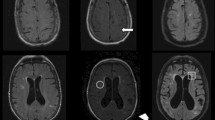Abstract
Late-onset idiopathic aqueductal stenosis (LIAS) has been recognized as one of the clinical entities of adulthood hydrocephalus for decades, although there have been no radiological reports that show normal ventricular systems before the development of LIAS. We present here an adolescent case of LIAS with a previously normal ventricular system on magnetic resonance imaging (MRI). A 17-year-old boy had been suffering from chronic headaches and mild intellectual disability (MID) since he became a teenager, and this had prevented him from leading an ordinary school life. MRIs on admission showed triventriculomegaly from the aqueductal stenosis that had not been detected on previous MRIs, at least until the age of 6. An endoscopic third ventriculostomy was successfully performed, which improved both the headache and the MID. The developmental mechanism of LIAS remains unclear, although the membranous ependymal-like tissue observed in the aqueduct suggested the preceding existence of an inflammatory process around this region. To the best of our knowledge, this case was noteworthy because the development of LIAS was clearly demonstrated on MRI for the first time.


Similar content being viewed by others
References
Wilkinson HA, LeMay M, Drew JH (1966) Adult aqueductal stenosis. Arch Neurol 15:643–648
Bennett RT, Allen PB, Miller JD (1975) Non-tumoral stenosis of the aqueduct in adults. Surg Neurol 4:523–527
Little JR, Houser OW, MacCarty CS (1975) Clinical manifestations of aqueductal stenosis in adults. J Neurosurg 43:546–552
Balakrishnan V, Dinning TA (1977) Non-neoplastic stenosis of the aqueduct presenting in adolescence and adult life. Surg Neurol 7:333–338
Kelly PJ (1991) Stereotactic third ventriculostomy in patients with nontumoral adolescent/adult onset aqueductal stenosis and symptomatic hydrocephalus. J Neurosurg 75:865–873
Fukuhara T, Luciano MG (2001) Clinical features of late-onset idiopathic aqueductal stenosis. Surg Neurol 55:132–136, discussion 136-137
Oi S, Shimoda M, Shibata M, Honda Y, Togo K, Shinoda M, Tsugane R, Sato O (2000) Pathophysiology of long-standing overt ventriculomegaly in adults. J Neurosurg 92:933–940
Bellastella A, Bizzarro A, Coronella C, Bellastella G, Sinisi AA, De Bellis A (2003) Lymphocytic hypophysitis: a rare or underestimated disease? Eur J Endocrinol 149:363–376
Suzuki K, Izawa N, Nakamura T, Hashimoto K, Ouchi K, Sakuta H, Asakawa Y, Numao A, Hirata K (2011) Lymphocytic hypophysitis accompanied by aseptic meningitis mimics subacute meningoencephalitis. Intern Med 50:2025–2030
Author information
Authors and Affiliations
Corresponding author
Rights and permissions
About this article
Cite this article
Kita, D., Hayashi, Y., Kitabayashi, T. et al. Detection of the development of late-onset idiopathic aqueductal stenosis (LIAS) by chronological magnetic resonance imaging: a case report. Childs Nerv Syst 30, 1317–1319 (2014). https://doi.org/10.1007/s00381-014-2354-2
Received:
Accepted:
Published:
Issue Date:
DOI: https://doi.org/10.1007/s00381-014-2354-2




